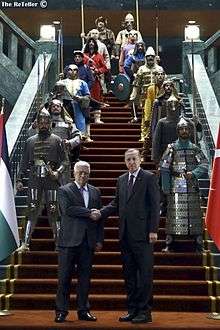Historic states represented in Turkish presidential seal

16 Great Turkic Empires[1][2][3] (Turkish: 16 Büyük Türk Devleti) is a discourse of Turkic history that was created in 1969 to explain the meaning of 16 stars of the presidential seal of Turkey.[1]
The concept was proposed in 1969 by Akib Özbek.[4] [5] It was inaugurated in 1985 for what is still the presidential seal of today.[1] Each star symbolizes a "historic Turkic empire" according to the Presidency of the Republic of Turkey.[5] Before this thesis was asserted, the 16 stars of the presidential Seal of Turkey was explained as "16 Turkic beyliks".[6] (Beyliks were Turkish principalities emerged between the 13th-15th centuries, after the fall of Seljuks)
The list
The names of 16 "Great Turkic Empires" are listed below.
| Flag | Turkish name[7] | English translation[8] | Founder [note 1] | Article | Dates[note 2] |
|---|---|---|---|---|---|
| Büyük Hun İmparatorluğu | Great Hunnic Empire | Touman | Xiongnu | 220 BC-46 BC | |
| Batı Hun İmparatorluğu | Western Hunnic Empire | Panu | (possibly Southern Xiongnu) | 48-216 | |
| Avrupa Hun İmparatorluğu | European Hunnic Empire | Balamber | Hunnic Empire | 375-469 | |
| Akhun İmparatorluğu | White Hunnic Empire | Khingila | Hephthalite | 390-577 | |
| Göktürk İmparatorluğu | Göktürk Empire | Bumin Khan | Turkic Khaganate | 552-745 | |
| Avar İmparatorluğu | Avar Empire | Bayan I | Avar Khaganate | 565-835 | |
| Hazar İmparatorluğu | Khazar Empire | Ziebel | Khazar Khaganate | 651-983 | |
| Uygur Devleti | Uighur State | Kutluk Bilge Köl | Uyghur Khaganate | 745-1369 | |
| Karahanlılar | Karahanids | Bilge Kul Qadir-Khan | Kara-Khanid Khanate | 840-1212 | |
| Gazneliler | Gaznavids | Alp Tekin | Ghaznavids | 962-1186 | |
| Büyük Selçuklu İmparatorluğu | Great Seljukid Empire | Selçuk Bey | Great Seljuq Empire | 1040–1157 | |
| Harzemşahlar | Harzemshahs | Muhammad I of Khwarazm | Khwarazmian dynasty | 1097–1231 | |
| Altınordu Devleti | Golden Horde State | Batu Khan | Golden Horde | 1236–1502 | |
| Büyük Timur İmparatorluğu | Great Timur Empire | Timur | Timurid Empire | 1368–1501 | |
| Babür İmparatorluğu | Babür Empire | Babur | Mughal Empire | 1526-1858 | |
| Osmanlı İmparatorluğu | Ottoman Empire | Osman I | Ottoman Empire | 1299-1922 |
Presidential Palace representation

The armors and war clothes of 16 countries are represented in Presidential Palace by the troops of guardsmen during official visits. The first representation were during Mahmoud Abbas's Turkey visit in January 2015. [9]
Criticism
It needs further linguistic evidence to list some of these states as Turkic states. Nihal Atsız notes that while some states with questionable Turkic identity were included in the list, some Turkic states (such as Akkoyunlu) were left out. He calles the list "fabrication".[10]
See also
- List of Turkic dynasties and countries
- History of the Turkic peoples
- Timeline of the Turks (500–1300)
References and notes
- Notes
- References
- 1 2 3 Central Eurasian Studies Review, Vol. 3, Central Eurasian Studies Society, 2004, p. 23
- ↑ H. Feridun Demokan, Contemporary Turkey: Geography, History, Economy, Art, Tourism, Demokan, 1978, p. 4.
- ↑ Necdet Evliyagil, Sami Güner, Basın-Yayın Genel Müdürlüğü, Ajans-Türk, Türkiye: Cumhuriyetin 50. Yıl Kitabı, Ajans-Türk Matbaacılık Sanayii, 1973.
- ↑ Haber yayınları (Nihal Atsız's essay)
- 1 2 Official website ot the presidency
- ↑ X. Türk Tarih Kongresi, Türk Tarih Kurumu Basımevi, 1994, p. 2947. (Turkish))
- ↑ Official website of the presidency (Turkish)
- ↑ "The Meaning of the Sun and the Stars in the Flag of Office" in the official website of the presidency (in English)
- ↑ "Spear-carriers and chainmail warriors: Erdogan's palace welcome". Yahoo! News. Retrieved 14 January 2015.
- ↑ On line history newpaper ((Turkish)) Nihal Atsız (Turkish)
External links
- Büyük Türk Devletleri (Smart cards of Türk Telekom)
- Hüseyin Nihâl Atsız, "16 Devlet Masalı ve Uydurma Bayraklar" (16 State tales and fake flags), Ötüken , 65. sayı, 1969.(Turkish)
- Yılmaz Özdil's essay (Turkish)